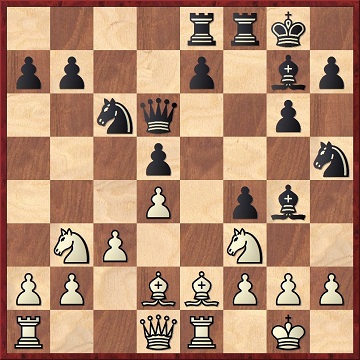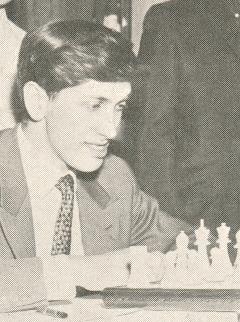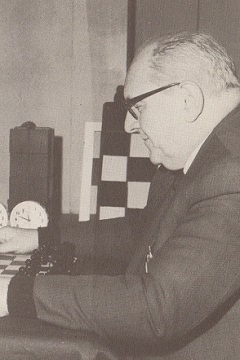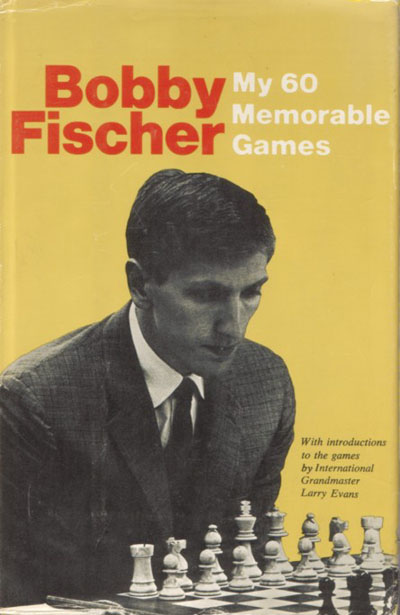
Edward Winter

White to move
Under the heading ‘Genius or mortal?’ Amatzia Avni (Ramat-Ilan, Israel) writes to us:
‘I recently read Elie Agur’s fabulous book Bobby Fischer: A Study of His Approach to Chess. Position 218 (pages 172-176) describes a fragment from Fischer’s game, as White, against Czerniak (Netanya, 1968):
The game went (! and ? by Agur): 15 Nc1! Bxf3 16 Bxf3 e5 17 Qb3!! exd4 (17…e4 18 Rxe4 {18 Bxe4?! Rxe4 19 Rxe4 Na5 20 Qa4 dxe4 21 Qxa5 f3} 18…Na5 19 Rxe8! Nxb3 20 Rxf8+ Bxf8 21 axb3 with advantage.) 18 Nd3! Rd8 19 c4! dxc4 20 Qxc4+ Kh8 21 Re6 Qb8 22 Rae1! Rc8 23 Bxc6. White regained his pawn, holding a large positional advantage. He went on to win.
Agur is full of praise for White’s play. “It isn’t very easy to define genius at chess. This though is a very good example of it”, he writes. “The plan Fischer contrives here is a combination of positional elements which viewed one by one are each a déjà vu idea. Put together, they are an exceptional ‘never seen before’ conception.”
During the 1970s I was one of several students of the late International Master Moshe Czerniak, at the Tel Aviv chess centre. I vividly recall him presenting us this game. Czerniak was impressed by Fischer’s play but revealed one interesting episode. Analyzing the game afterwards, Czerniak asked Fischer what he would have played against 17…e4. Fischer indicated that it was impossible, because he would simply take on e4. When Czerniak showed the line 18…Na5 Fischer thought for a while and, of course, was quick to point out the positional queen sacrifice 19 Rxe8!, which is why Czerniak had not embarked upon that variation. Thus the genius plan was successful because of a certain amount of luck, given that Fischer had missed the critical tactical justification in his preliminary calculations.’
(2317)


Bobby Fischer and Moshe Czerniak
From Elie Agur (Amsterdam):
‘I happened to be present at the “joint analysis” of the Fischer v Czerniak game, in the first row, about two metres from the players. What Czerniak referred to as joint analysis took no more than five minutes and ended when Fischer expressed his dissatisfaction with Czerniak's suggested lines by playing his rook from a1 to a3, even though the pawn on a2 prevented it from being a legal move. He then left the hall, while Czerniak lingered there for a while, watching the other games. The only position they analysed in any depth was indeed the one after White’s 17th move, and I couldn't detect any hesitation by Fischer in indicating the critical line. The only person who can confirm this story is Fischer himself, and I trust he remembers it, including his Ra1-a3 “manoeuvre”, yet I doubt whether confirmation would be forthcoming.
From 1971 to 1974 I worked with Czerniak on a long series of chess programmes for the Instructional Television Center in Tel Aviv, and naturally we devoted a lot of time in our weekly meetings to talks about chess history, players, etc. His huge knowledge and experience of the game, and passion for it, as well as his personal acquaintance with many of the greatest players of this century, including Capablanca, Alekhine and Tal, made these talks a source of recurrent delight for me. Naturally we talked about Fischer too, whom Czerniak considered to be the most talented player in chess history, with the sole possible exception (according to him) of Pillsbury. I heard from Czerniak the same version about his game with Fischer as recounted by Mr Avni, yet so as not to embarrass him I didn’t tell Czerniak I had been present there at the time. Since I considered this episode to be too personal to include in my book on Fischer, I decided to handle the position in the most objective way possible. I do maintain that it is one of the most striking examples of chess genius.’
(2327)
Below are two interesting paragraphs from Kasparov’s Foreword to Elie Agur’s book:
‘When I compare my own career with that of Fischer, I have to admit that I enjoyed a certain advantage over him. He had no-one besides himself to draw him up to the heights he reached, whereas I have been privileged in having a high-class player like Karpov, who forced me to exert myself and advance ever higher.
If one may judge a player’s strength by comparing him with his contemporaries, it seems to me that Fischer’s achievement is unsurpassed – the gap between him and his closest rivals was the widest there ever was between a World Champion and the other top-ranking players of his time. He was some 10-15 years ahead of his time in his preparation and understanding. This could be attributed in part to his dedication to the game, which was unequalled by any other player before or since.’
(2328)

In his Introduction to the ChessBase CD World Champion Fischer Robert Hübner writes as follows regarding My Sixty Memorable Games:
‘Most critics deem Fischer’s comments to be entirely devoid of errors, and each and every one of his observations is accepted as gospel truth. I was plagued by the desire to find out whether this reputation is indeed justified. Unfortunately, however, there is only one way of finding out: get down to the hard work of going through all of Fischer’s notes; and so I went through his oeuvre of annotations to find passages that seemed dubious to me.’
Hübner also analysed games not included in Fischer’s book, and one of them relates to a position which was discussed in C.N.s 2317 and 2327 by Amatzia Avni and Elie Agur (see pages 30-31 of A Chess Omnibus). The following position arose after Black’s 14th move in Fischer v Czerniak, Netanya, 1968:

Page 173 Agur’s book Bobby Fischer: A Study of His Approach to Chess (London, 1992) had given Fischer’s next move, 15 Nc1, two exclamation marks, with the following comment:
‘It isn’t very easy to define genius at chess. This though is a very good example of it. The plan Fischer contrives here is a combination of positional elements which viewed one by one are each a déjà vu idea. Put together, they are an exceptional “never seen before” conception.’
Hübner analyses the position, mildly criticizing 15 Nc1 (instead of which he recommends 15 h3), 15…Bxf3 (15…e5 is found to lead to approximate equality) and 17 Qb3 (17 dxe5 Nxe5 18 Nb3 is preferred). Above all, Hübner singles out 17…exd4 as a bad mistake (instead of which, he says, 17…Nf6 led to a roughly equal position).
The CD is in both German and English. Not all the games in Fischer’s book are discussed by Hübner, but in those which are featured he picks out key positions for detailed scrutiny, sometimes agreeing with Fischer’s conclusions and sometimes differing.
(2948)
See also the detailed discussion of the Fischer v Czerniak game on pages 180-194 of Materialien zu Fischers Partien by Robert Hübner (Ludwigshafen, 2004).
See too: Articles about Bobby Fischer.
Latest update: 3 April 2025.
To the Chess Notes main page.
To the Archives for other feature articles.
Copyright: Edward Winter. All rights reserved.